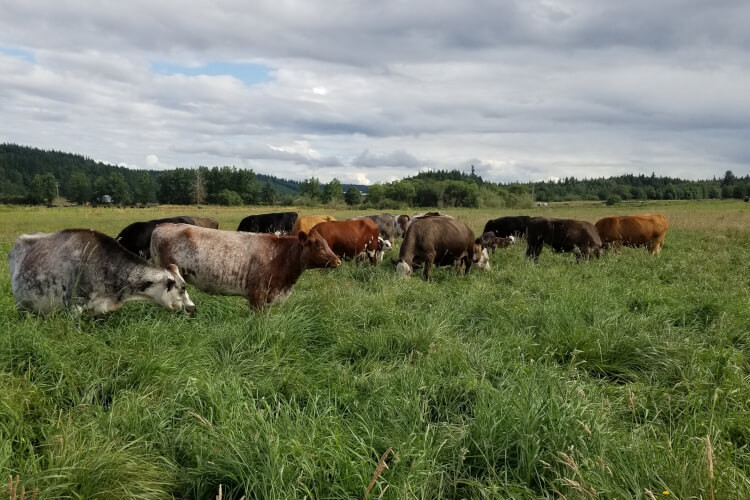Our Profession of Hope
posted on
November 20, 2023

When we moved into our old house, there was a sun-faded print on the wall that said simply, “Farming Is A Profession Of Hope.”
The phrase has repeated itself in my mind over the years and I’m always struck by the duality of the message and wonder if it was intended. And if the duality was an accident of words, I wonder which was the intended meaning.
Do the faded words mean we are attesting (professing) that we have hope? Or does it mean that it is a vocation (a profession) that gives hope? Or, a third possible meaning – it is an occupation that requires hope?
Or perhaps they are all one and the same, bound together.
A choice of profession that indicates an innate confession that we have hope, because without hope we could not succeed at this difficult task of farming which, in its turn, bestows hope.
Perhaps it may seem superfluous, to apply meandering philosophic thoughts to farming and its set of tasks so deeply grounded and made possible by science, engineering and technology.
But the art of observation, of the ability to truly be able to see what the land and animals are telling us, to appreciate nuance, is needed, too. And isn’t that the seed of philosophy? To attempt to understand a world that so often seems without reason. To undertake that endeavor is to have hope.
Which brings us, at last, back to farming.
Yes, I can tell you that we, your farmers, profess that we have hope. To persevere in such a maelstrom of unknowns as this, hope is a requirement.
You see, it’s going to rain when you really need the soil to dry out. It’s not going to rain when the grass is withering and dying of drought. Illness will arrive despite your best preventions. The list is always too long to accomplish. And pretty much every predator, whether on the land or in the air, thinks chicken is the best meal to enjoy every day of the week.
So, in the face of all that, hope is required to forge ahead.
And yet, seemingly at odds, this profession that requires hope to even attempt it also BESTOWS hope.
I spent much time pondering this duality, because while I felt it to be true in my heart my mind needed to understand why.
And I think, in part, we are blessed with the gift of hope by the very trials that require us to face them with hope.
You see, these events we call trials are all part of the natural cycles of this beautiful planet. The cycle of life and death, of destruction and birth and regrowth, and the constant eating and being eaten of all the life forms around us, from the most microscopic to the largest.
I realized, finally, that being intimately connected to this constant, natural cycle is what is so grounding and gratifying. The seasons change and the cycle of life moves on, inexorably, with or without our consent.
And day after day, year after year, we see the growth and perseverance and restoration all around us, and in this we find our hope.
And we are not alone in this. Through the miracles of technology we are members of diverse farming groups around the country (the world, really), and what we hear and read coming from these other farmers is beyond inspiring.
We all face many, many challenges, but smart, resourceful, dedicated, motivated people all over the country, and the world, are coming together and they’re not there to complain, place blame, or criticize.
Instead they are all sharing their experiences, their knowledge, and their skills to pull everyone up together as we all reach towards the same goals of feeding our communities and tending our soil, our animals, and our mother earth with love and respect.
Let me tell you, innovation (the child of hope) is rampant! Every day we're reading of a brilliant solution a fellow farmer developed for one of the many challenges we all face. And these farmers are not trademarking their ideas, either. Nothing distant and proprietary, here. They're handing out their ideas for free. Because they're just so darn excited to successfully solve a problem and they want everyone else to be saved the same blood, sweat and tears they poured out.
Each regenerative farm that succeeds is not competition. They're inspiration. And encouragement. That together we can truly make a difference in the future health of our environment, our animals, and our customers.
The immense intelligence of our fellow farmers, being thrown at the problems that we all face, is heartening.
Hope. Hope. Hope!
It is our joy to share this hope with you.
And we hope you know just how important you are to us, and just how necessary you are in this cycle of hope.
Without you, making the choice you do to buy your food from us, all the hope we bring to the profession would be for naught.
And the hope that can be gifted on the world by this profession of regenerative, earth healing, body healing, direct-connection-to-your-food farming would trickle away.
We feel blessed to be your farmer and connect you, through your food, to the earth that sustains us and the HOPE that it bestows.




